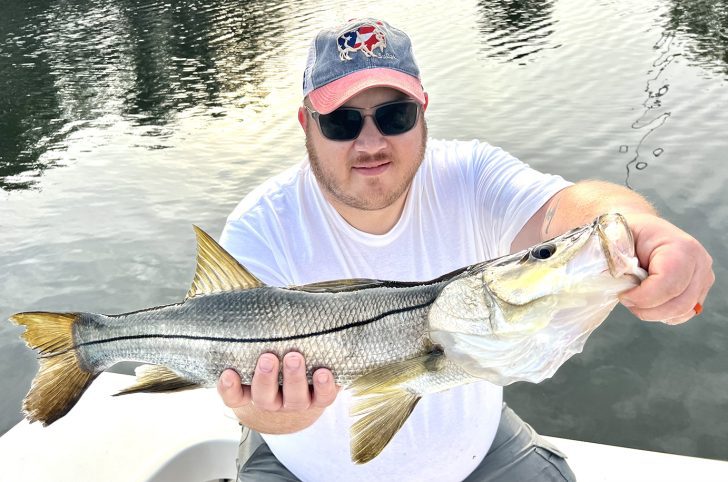Springtime is Slam Time!
If you’ve never achieved an “Inshore Slam,” now is the time!
Every year, when Spring rolls around, the grass flats throughout Tampa Bay come alive. As baitfish start moving onto the flats, snook, redfish and seatrout follow. When this occurs, it’s the easiest time to achieve an inshore slam. If you don’t know what that is, it’s when you catch slot-size (or over) snook, redfish and seatrout on the same outing.
Now, many of you may think that should be easy. Well, it’s easier said than done for some people. You’d be surprised how many people who have been fishing with me that have never caught a slam. Occasionally, I meet a few anglers who have lived in the Tampa Bay area and fished all their life, but the slam eludes them.
If an inshore slam is something you would like to pursue, you might assume that catching a slot-size seatrout would be the easiest and save that for last. Not necessarily–at times it can be the most difficult to land. That’s why, many times, I’ll start out fishing around some sandy potholes on the grass flats trying to catch the seatrout first. If I have no success, I’ll move on to snook and redfish and come back to seatrout to close the deal.
While in pursuit, here’s where you should be looking for that snook and redfish. With water temperatures back in the low 70s snook are moving out of the back bays, creeks, and rivers and seeking shelter along the mangrove shorelines and points. Snook feed best on a good tidal flow. Some days, it may vary whether they prefer an incoming or outgoing. So, just make sure the current is moving.
To get the action going, toss out a few live scaled sardines and wait for the snook to respond by attacking the freebies. Once they start feeding, cast a hooked live sardine to the same spot for an instant hook up. If you get lucky, you’ll be able to catch numerous snook in the same spot and also land one over 28 inches. If you do catch a big one at your first spot, move down the shoreline a hundred yards or so and try again.
If you’re fishing during an incoming tide and it’s reaching its peak, move on to redfish. Redfish like to feed on crustaceans around oyster beds and barnacle encrusted mangrove roots during a high tide. Find a spot with both, and you’ve found a redfish goldmine. Redfish also like to travel with mullet. The reason, mullet flush baitfish and crustaceans out of the grass as they feed. Anytime I spot a school of mullet, I get out in front of them and Power Pole down.
In either scenario, always start by chumming with scaled sardines. After that, cast a bait out that’s suspended under a cork. Once the cork goes under, give the fish 2 to 3 seconds to eat the bait, then when you reel and get your line tight, lift your rod for a solid hook set.
Let’s say after a day on the water you caught all three inshore slam species, but they weren’t all big fish. You still achieved a slam, just not an official inshore slam. There’s always next time.
Tarpon and Spanish mackerel will be migrating to the Tampa Bay as we approach-April. Tarpon start showing up first around the Sunshine Skyway Bridge and the Port of Manatee. One of the best fishing technics to use around the bridge is to Spot Lock or anchor your boat between the pilings and start a fresh cut bait slick. Once you have a slick established, start freelining hooked live bait within the slick. If you’re fishing at the port, do more of a spot and stalk, or just drift fish past the schools.
Spanish mackerel make their presence at the mouth of Tampa Bay and slowly end up all the way past the Countney Campbell Causeway. Early on, you mainly catch them around the bridges, artificial reefs, and range markers. As time goes on, Spanish mackerel start moving onto the grass flats as they feed on baitfish. There have been times when I’ve caught them in as little as two feet of water.
Some people claim Spanish mackerel aren’t good table fare. Not true. The key to good fillets is to ice the fish down immediately, and always cut the bloodline out when filleting.
Afishionado, “Always an Adventure.”

